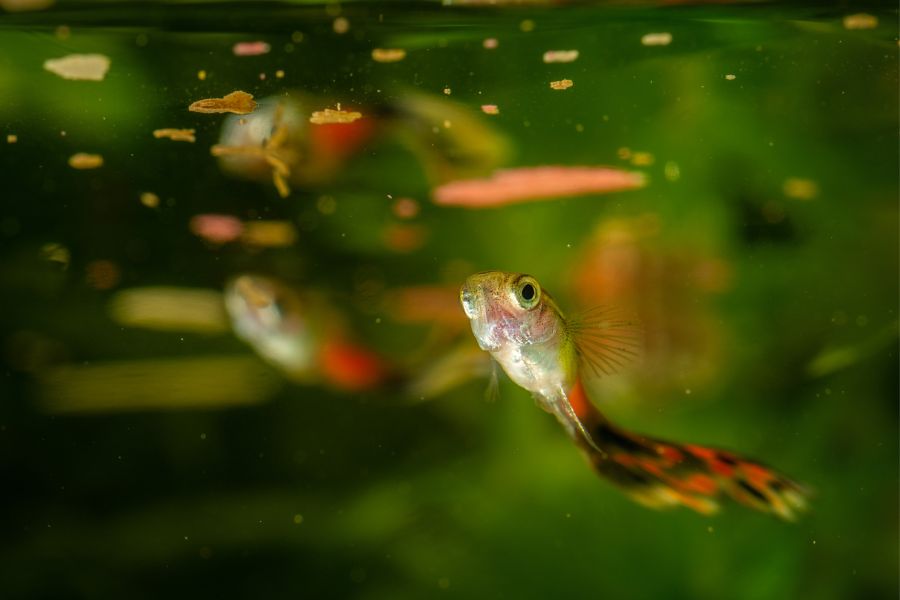Guppies sometimes referred to as million fish, are beloved aquatic animals that are recognized for their vivid colors and joyful temperament.
Because of their resilience and versatility, they are a preferred option for both novice and professional fish keepers.
Just like all biological creatures, guppies are vulnerable to a variety of illnesses that could make them sick or even kill them.
Guppy caretakers should be able to identify the signs of serious ailments and take the necessary steps to eliminate or cure them.
In this guide, the most prevalent ailments affecting guppies will be covered, along with their symptoms, underlying reasons, and available remedies.
By being aware of the common health issues that guppies experience, we can make our pet’s life much easier and provide them with all our love and care.
18 Diseases What Every Fish Keeper Should Know
1. White Spot Disease/Ich
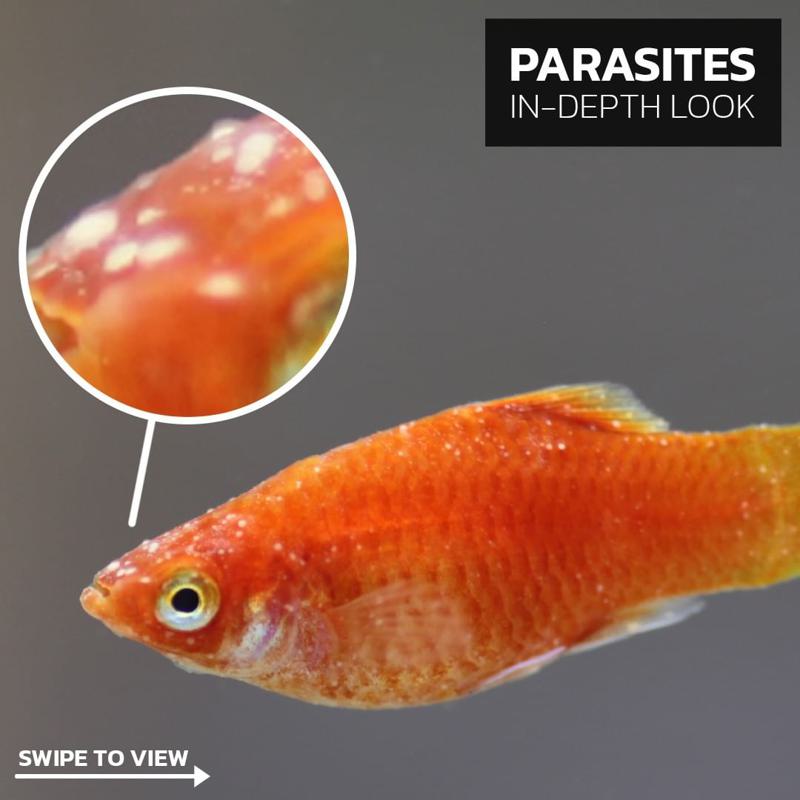
White Spot Syndrome, often referred to as Ichthyophthiriasis or just Ich, is triggered by the parasite Ichthyophthirius multifiliis. The parasite penetrates inside the fish via gills and sticks to the stomach, fins, and gills of the organism.
Poor water quality, especially significant concentrations of nitrite, nitrate, and ammonia, stress from overpopulation, inadequate nutrition, or abrupt changes in temperature or water chemistry, are the most frequent causes of Ich.
Symptoms
- Tiny white dots all over the body and fins
- Inability to eat
- Fast breathing
- Fatigue
- Redness on the body and fins
- Death may occur in extreme circumstances.
Treatment
- Raise the water temperature to 82-86F to speed up the life cycle of the parasite.
- Use Ich medication by adding it to the water or by dipping the fish in a medicated solution
- Maintain good water quality by performing regular water changes
- Ensure that the pH, nitrite, nitrate, and ammonia levels are within the recommended range for guppies.
2. Fin and Tail Rot
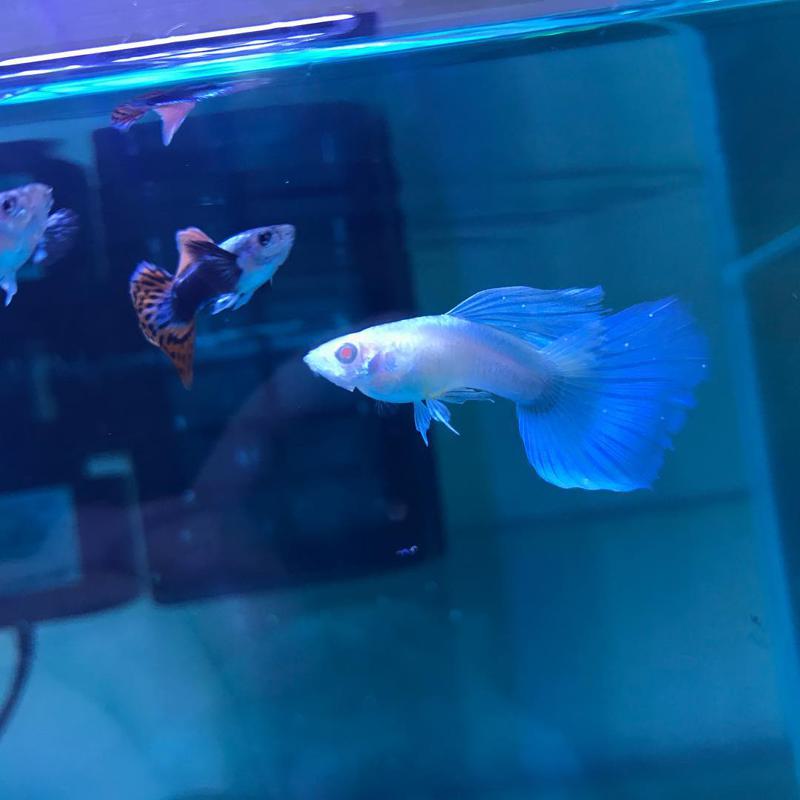
Fin and tail rot is triggered by a microbial infestation, which is usually the result of poor water quality, like excessive nitrite, nitrate, and ammonia concentrations. Fin rot may also result from physical harm to the fins, inadequate nutrition, or other underlying medical conditions that compromise the fish’s immune system.
Symptoms
- Damaged tails and fins
- Discoloration
- Tissue deterioration
- Tattered and flaked fins and tail
- Fins with faded or rotted ends
Treatment
- Use a quarantine tank to isolate the affected fish
- Use antibiotics to eliminate the bacterial infection, such as Maracyn, Kanamycin, or Tetracycline
- Consider using a medication specifically for fin rot, such as Jungle Fungus Clear
3. Swim Bladder Disorder
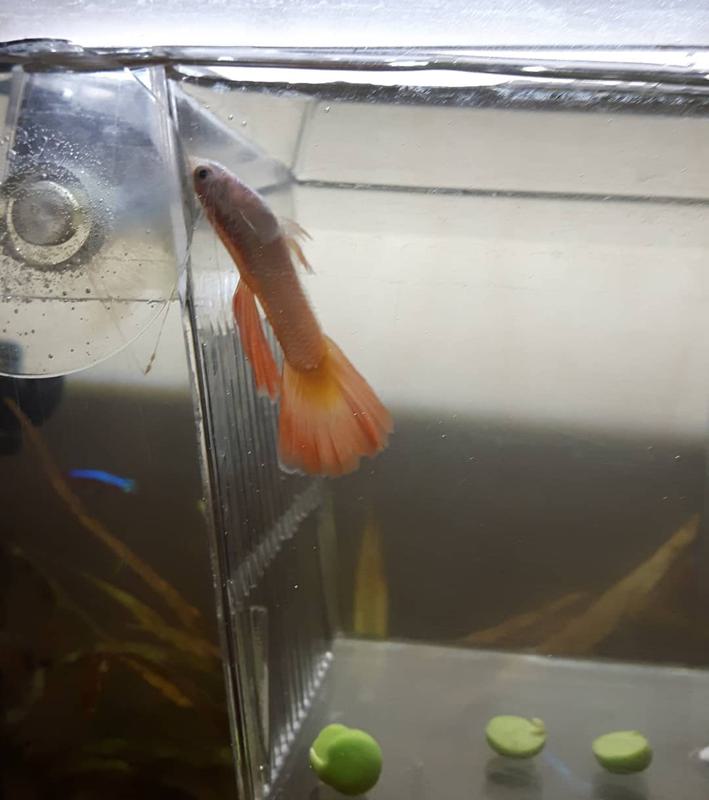
Swim bladder disorder is a syndrome that affects the swim bladder, a sac close to the fish’s backbone that regulates buoyancy.
Overeating, constipation, and biological abnormalities are some of the most typical causes of a swim bladder disorder.
Additional probable reasons include physical harm, exposure to pesticides or harmful substances, and certain pathogen or microbial species.
Symptoms
- Experiencing difficulties in swimming
- Floating at the top or sinking to the tank’s substrate
- Incoordination or a fractured spine
- Having trouble staying straight
- Balance issues
- Reduced appetite
- Lethargy
- Dilation in the abdomen
Treatment
- Identifying and addressing the underlying cause of the condition
- Reducing the frequency and amount of feeding
- Use a constipation remedy
- Addressing any underlying health issues
- Use antibiotics if a bacterial infection is a cause
- Provide proper nutrition and maintain good hygiene practices
4. Columnaris & Mouth Fungus
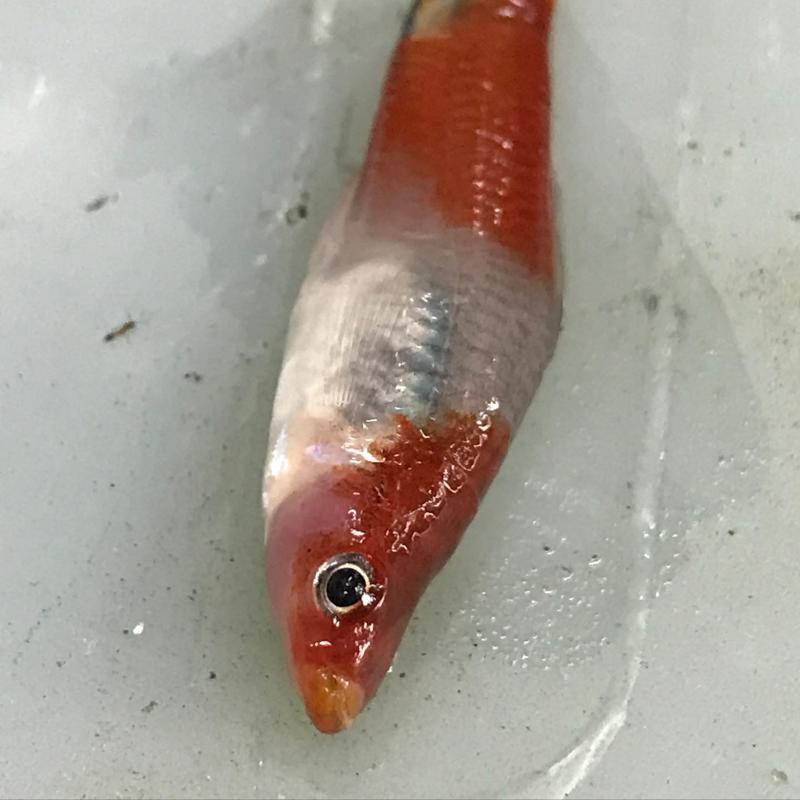
Columnaris is a pathogenic illness induced by Flexibacter columnaris, a common freshwater aquarium parasite. It is strongly associated with bad water conditions and a significant amount of stress in fish.
Mouth fungus, commonly referred to as cotton mouth or cotton wool infection, is carried on by a fungal pathogen named Saprolegnia that can infiltrate the fish’s mouth and gills.
Both mouth fungus and columnaris are opportunistic illnesses that can affect fish that are already under stress or who have weak immune systems.
Symptoms
- White or grey ulcerations all over the fish’s body, fins, and head
- Having trouble swimming
- Skin irritation in the fins and body
- White cotton-like benign cysts on the lips, gills, and fins of the species
- Eating disorders
Treatment
- Provide good oxygenation in the tank, adding an air stone or a power head
- Use a water conditioner to detoxify the water
- Keep the tank clean and free of debris
- Avoid overcrowding and overfeeding
- Consider using a UV sterilizer to kill off bacteria in the water
5. Velvet (Oodinium)
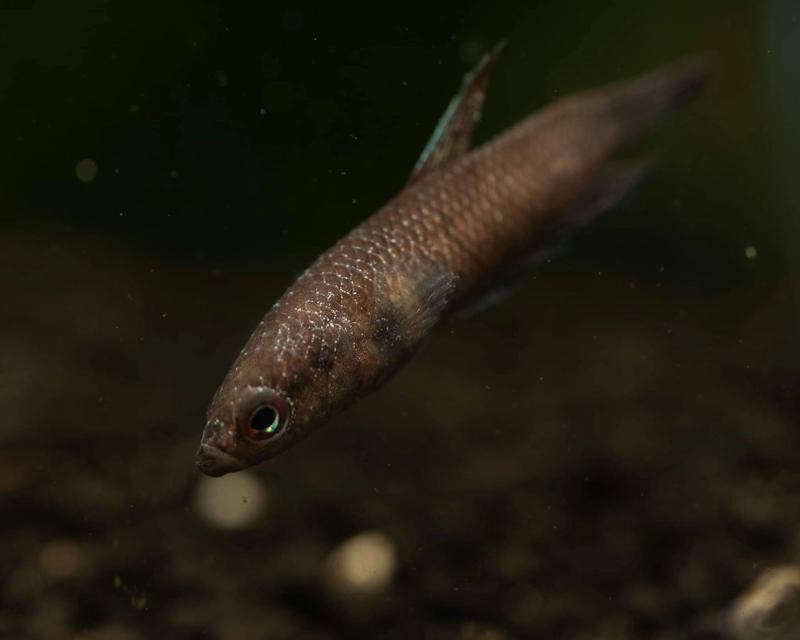
Oodinium pilularis, a single-celled organism, is the pathogen responsible for this parasitic illness. The parasite is common in freshwater tanks and can harm animals that are currently suffering from other medical complications or living circumstances.
Velvet may also be transferred into an aquarium by contaminated fish or live food. Poor water quality, high temperatures, and excessive fish numbers can all make fish more vulnerable to velvet.
Symptoms
- The fish’s body, fins, and gills have a golden or rusty sheen that resembles dirt particles.
- Having trouble swimming
- Lethargy
- Loss of appetite
- Rubbing against stuff
- Twisted fins
Treatment
- Use of a specific medication, such as CopperSafe, or a combination of medications like Formalin and Malachite Green
- Consider using a UV sterilizer to kill off parasites in the water
- Improving water conditions by performing regular water changes
6. Popped Eyes (Popeye)
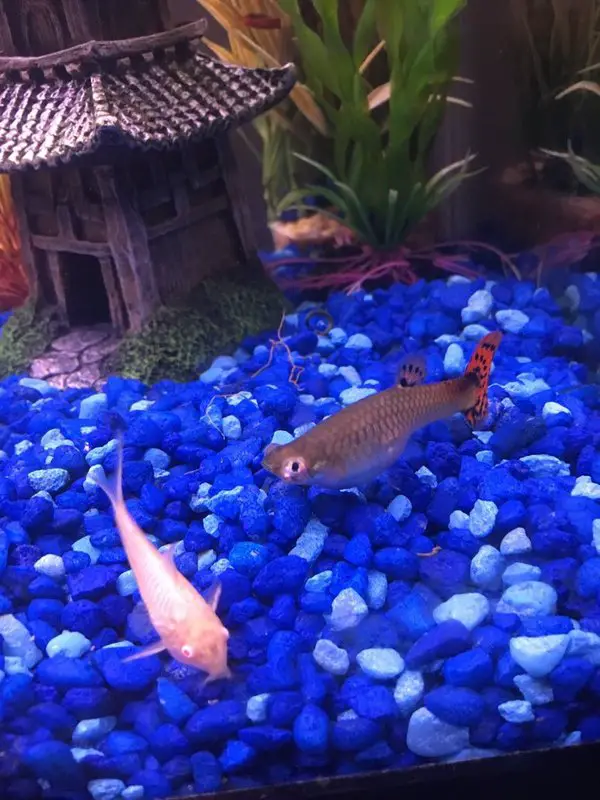
Popped Eyes, often described as Popeye, is a disorder in which one or both of a fish’s eyes emerge from their sockets. Popeye tends to result from bacterial infections, physical trauma, and dietary imbalances.
Other possible reasons include contact with pollutants or chemicals, as well as certain infections or illnesses that compromise the fish’s immune system.
Symptoms
- One or both eyeballs poking out of their sockets
- The damaged eye seems hazy or yellowish
- Irritation or infection around the eye
- Hypersensitivity to light
- Eye dryness or leakage
- Iris color transition
- Visual impairment
Treatment
- Using antibiotics like erythromycin
- Ensuring good nutrition, including a vitamin A-rich diet
- Isolating the impacted fish to stop the virus from spreading to other fish
- Giving medicine to treat parasite infections
- Surgery may be needed if the cause is a physical injury
7. Red Blood Spot
Red Blood Spot, commonly described as Hemorrhagic Septicemia, is a microbial disease driven by the gram-negative microorganism Aeromonas hydrophila. The illness is identified by red or purple markings on the animal’s body, fins, and tails.
It is found to be linked to bad living conditions and an excessive amount of stress in species. The microorganism thrives on the animal’s lymphocytes and could invade the animal with its tails, scales, and fins.
Symptoms
- Red and purple markings all
- Having trouble swimming
- Bleeding internally on the gills, tail, and spine
- Skin discoloration
Treatment
- Changing the water regularly to improve the water quality
- Check that the acidity, nitrate, phosphorous, and ammonium concentrations are within the guppies’ normal limit.
- Keep an eye on the water parameters and adjust them if necessary, such as pH, hardness, and chlorine.
8. Camallanus Worm
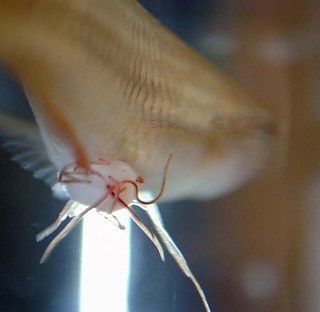
A nematode worm called Camallanus cotti is the source of the pathogenic illness called the camallanus internal worm.
The fish becomes infected when it consumes the infective phase of the worm, which is often present in living food or the environment.
Bad water quality, overfeeding and overstocking the tank could make fish more vulnerable to Camallanus internal worms.
Symptoms
- Red worm-like outgrowth from the fish’s rectum
- Inability to eat
- Weight reduction
- Bloating
- Less activity
Treatment
- Use of medication such as Levamisole, Praziquantel, or Fenbendazole
- Change tank water once a week
- Feeding medicated food or using the medicated feed to treat the fish
9. Viral Hemorrhagic Septicemia (VHS)
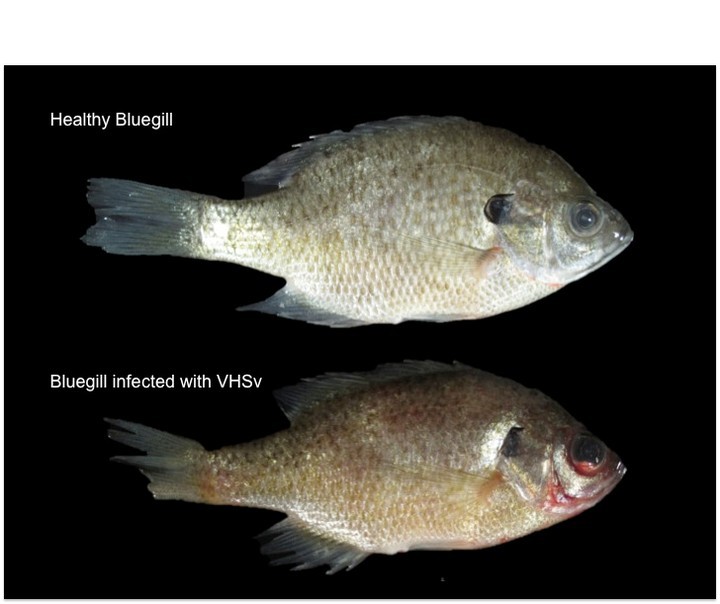
Viral Hemorrhagic Septicemia (VHS) is a life-threatening illness that is extremely infectious. Guppies are one of the many fish species that it may impact.
In addition to contaminating fish and fish items, the virus is mainly transmitted through water. Fish may be more vulnerable to VHS if they are in pain, are exposed to wild aquatic animals, have a high level of anxiety, or are in unsuitable water temperatures.
Symptoms
- Hemorrhaging on the gills, tail, and spine
- Inflammation in the head, cornea, and spine
- Skin hyperpigmentation
- Appetite loss
Treatment
- Isolate the affected fish immediately
- Disinfect the affected tank and equipment
- Make sure the tank requirements are acceptable for guppies
- Avoid overcrowding and stress to fish
- Observe the fish closely and quarantine new fish before introducing them to a healthy tank
10. Scoliosis (Bent Spine)
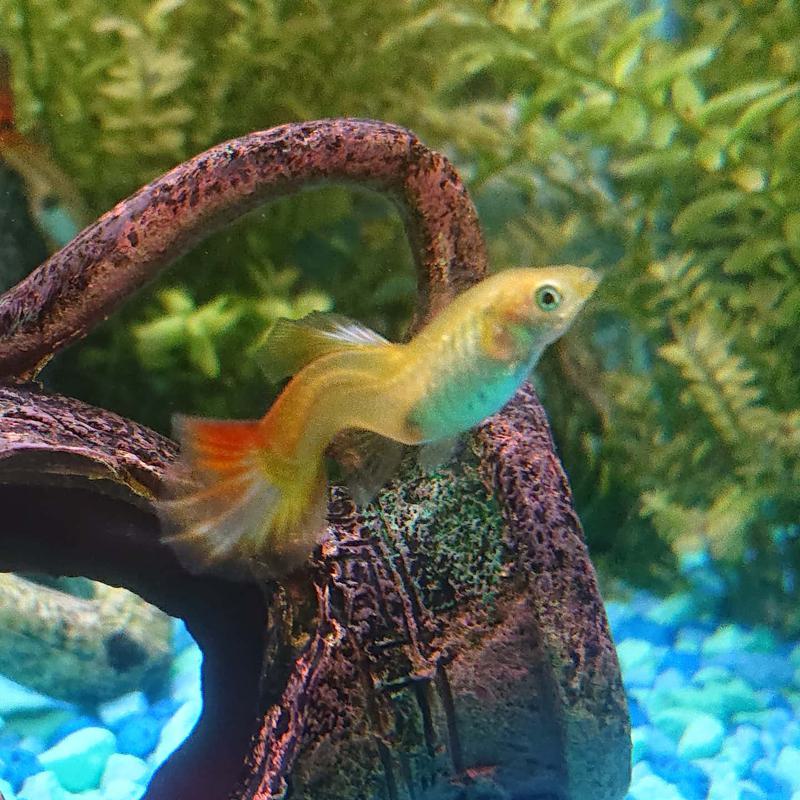
Scoliosis (Bent Spine) is a hereditary condition in which the animal’s spine bends in one direction. It is often a hereditary disorder that can be carried on by dietary deficiencies in calcium and vitamin D3, as well as by the surroundings and harsh tank conditions.
Symptoms
- The spinal curve is definitely evident
- Difficulty swimming
- Decreased mobility
Treatment
- Give your fish a balanced diet full of calcium and vitamin D3.
11. Fish Tuberculosis
Tuberculosis in aquatic species (Mycobacteriosis) is induced by Mycobacterium organisms and could be transmitted by direct encounters with polluted water, animals, or supplies. It can possibly enter a tank through diseased wild fish or by ingesting sick dead animals.
The symptoms are identical to those associated with other fish illnesses, like weight reduction, breathing difficulty, and noticeable bumps or lesions on the body and tail.
Symptoms
- Scars, blisters, and reddening on the fish
- Skin discoloration
- Diarrhea
- Small bumps or pustules on the body and tail
Treatment
- Remove the affected fish immediately
- Clean the impacted aquarium and tools
- Maintain a healthy tank environment
- Treat with Neomycin, Kanamycin, or Isoniazid antibiotics
12. Hexamitiasis
Hexamitiasis often called Hexamita is a pathogenic illness transmitted by the protozoan Hexamita.
A number of things, such as poor sanitation, overpopulation, and food rich in carbohydrates, might contribute to the illness, which mostly damages the stomach of fish.
Symptoms
- Diarrhea
- Diminished appetite
- Weight loss
- The skin becomes paler in appearance
Treatment
- Change your tank water by at least 60-70%
- Medicate the water with metronidazole or other antiparasitic medications
- Providing fish with medicated diet or mixing liquid medicine in the tank
13. Gill Flukes
Gill Flukes are pathogenic flatworms that attack fish gills. The parasites could harm and cause allergic reactions to the host by attaching to the gill membrane.
Bad aquarium temperature, overpopulation, and introduction to contaminated wild fish are only a few of the culprits of the infection.
Symptoms
- Breathing heavily at the tank surface
- Fins tightening
- Infection and hyperpigmentation of the gills
- Restricted appetite
- Overproduction of mucus surrounding the body or the gills
- Tiny blood vessels spots on the body and fins
Treatment
- Isolating the affected fish to prevent the spread of the infection to other fish
- Medicate the water with a medication containing praziquantel or other antiparasitic medications
14. Dropsy
Dropsy is a disorder that causes the animal’s body to inflate with fluid. Numerous things, such as respiratory diseases, viral outbreaks, bad tank quality, and internal organ damage, might contribute to the illness.
Symptoms
- Body soreness
- Pinecone-shaped scales
- Appetite loss
- Drowsiness
- Bloating
- Pop-eye
- Reddish undertones on the fins and body
- Swimming abnormalities
Treatment
- Can not be treated if a bacterial infection is a primary cause.
- 2 tbsp of Epsom salt mixed in 1 gallon of aquarium water could help the affected fish.
15. Protozoan
There are several types of unicellular parasites that can end up causing protozoan illnesses.
These parasites have a variety of ways to attack fish, such as contact with contaminated water or other animals or consumption of contaminated food.
It could also be developed by poor hygiene practices and low oxygen levels.
Symptoms
- Breathing heavily
- Struggling to breathe at the tank’s surface
- Abdominal pain and bloating
- Gas
- Indigestion
- Weight loss
Treatment
- Use a good quality heating system
- Malachite Green or Formalin could help in the initial stage
- Use copper medicine like Seachem Cupramine in extreme cases
- Keep your tank water clean
16. Tetrahymena
Tetrahymena is a family of pathogenic multicellular protozoans that mostly affect guppies. These bloodsuckers are pear-shaped organisms and have ciliated surfaces that enable them to travel and eat cellular substances on fish’s bodies.
However, they may also infect their host’s tendons, bodily cavities, and ophthalmic secretions, which can cause illness. Although other marine animals may potentially be impacted, guppies are extremely vulnerable to this pathogen and are usually the animal most impacted by Tetrahymena outbreaks.
Symptoms
- White markings on their sides and tails
- Twisted fins
- low appetite
- Uncomfortable breathing
- Fatigue
Treatment
- Use formalin or antibiotics that consists of malachite green and copper as an active ingredient
17. Anchor Worms (Lernaea spp.)
Lernaea spp. also called anchor worms, are microscopic invertebrates that attack fish. They use a hook-like tip to connect to the animal’s body, generally on the gills or tail.
The infection occurs when the guppy comes into contact with contaminated water or when a diseased animal or raw meal is eaten by them. Anchor worms may also live in dirt or plants, where they might attack animals that approach them.
Symptoms
- Parasites that can be identified clinging to the animal’s body or fins
- Stroking or brushing against aquarium surfaces
- Swelling or rashes in the damaged region
Treatment
- Remove the worm from your fish’s body
- Apply an antibiotic medication to the affected region
- Consult your vet for proper medication
18. Freshwater Fish Lice (Argulus spp.)
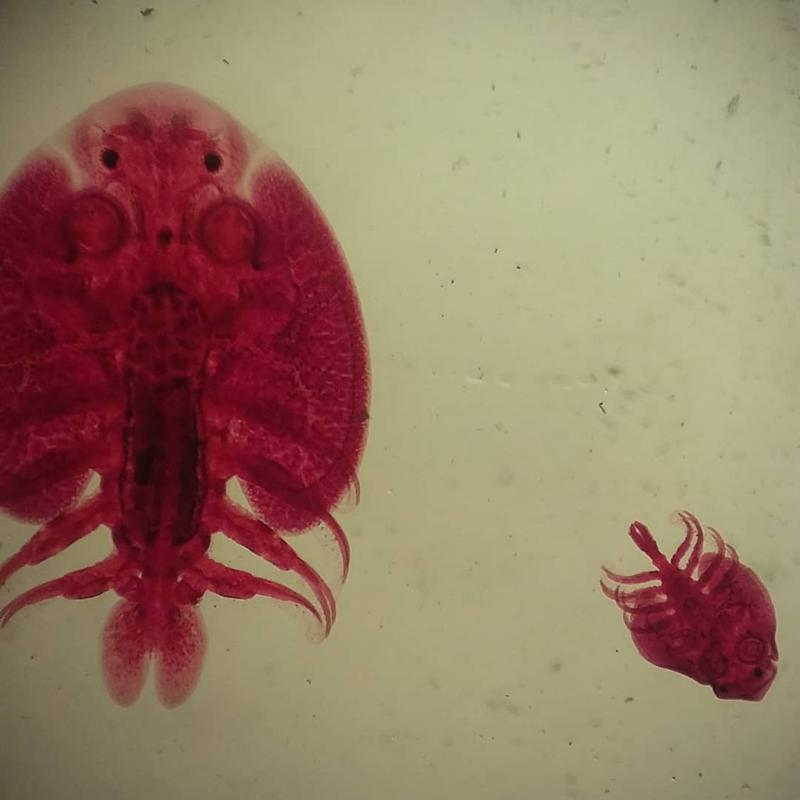
Freshwater fish lice, also known as Argulus spp, are tiny crustaceans that attach themselves to fish. They can be found on the fins or skin of the fish, and use a sucker-like mouth to cling on.
Unfortunately, fish that are infected with these lice often have a high mortality rate. It is mainly because the lice can carry other parasites that can lead to dangerous secondary infections.
Not only that, but the puncture site where the lice attached itself can become infected with bacteria or fungi. Outbreaks of fish lice can be a big problem for freshwater fisheries, and sometimes entire seasons have to be shut down in order to get rid of the lice.
Symptoms
- Spots on fish
- Scratching
- Inactivity
- Odd swimming behavior
Treatment
- Bigger lice could be removed from their bodies
- Remove eggs or larvae that are present in the aquarium
- Low-dose insecticides are best to permanently remove lice
Read More:
- How to Choose the Best Food for Guppies?
- Betta Fish Swimming Sideways
- Fish at Bottom of Tank: Why & Solutions
- Why Do My Fish Keep Dying?
- What is Neon Tetra Disease?
- Best Live Plants for Guppies Tanks
- Guppy Lifespan
FAQs
Can I Treat Guppy Diseases with Salt Baths?
Some guppy diseases can be treated with salt baths. For example, Epsom salt could help provide relief to the guppy and delay the severe symptoms. However, you can not expect it to miraculously treat the fish.
It is important to consult a veterinarian or an experienced aquarist before treating your fish with salt baths, as not all guppy diseases are treated with this method, and using the wrong methods could aggravate the problem.
What Should I Do if I Think My Guppy Is Sick?
If you suspect that your guppy is sick, it is important to separate it from other fish in the tank and consult a veterinarian or an experienced aquarist.
Additionally, improving water conditions by performing regular water changes, ensuring that the pH, nitrite, nitrate, and ammonia levels are within the recommended range for guppies, and maintaining good hygiene practices may help to improve the fish’s condition.
Conclusion
Guppies are a beloved and hardy species of fish, but they are still prone to a range of diseases. As a fish owner, it’s important to familiarize yourself with common guppy diseases, their symptoms, and treatments.
By keeping a close eye on your guppies and taking preventative measures such as maintaining good water quality, providing a well-rounded diet, and avoiding overcrowding, you can help ensure that your guppies remain healthy and happy.
Remember that early detection and intervention are key, so do not hesitate to seek help from a veterinarian or experienced aquarist if you suspect that your guppy is ill.
Keep your guppy tank clean, healthy, and well-maintained, and your guppies will reward you with beautiful colors, graceful movements, and long lives.
